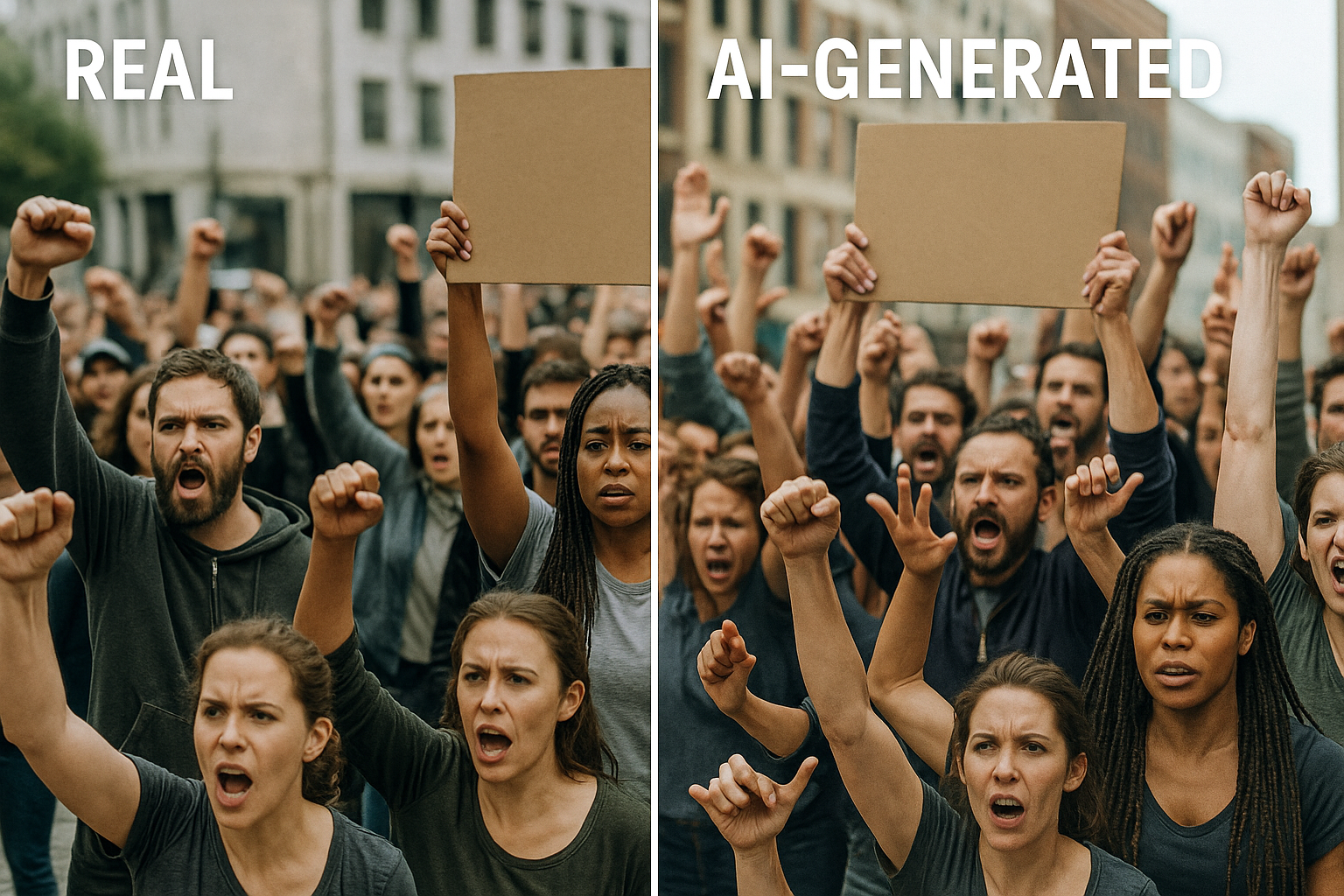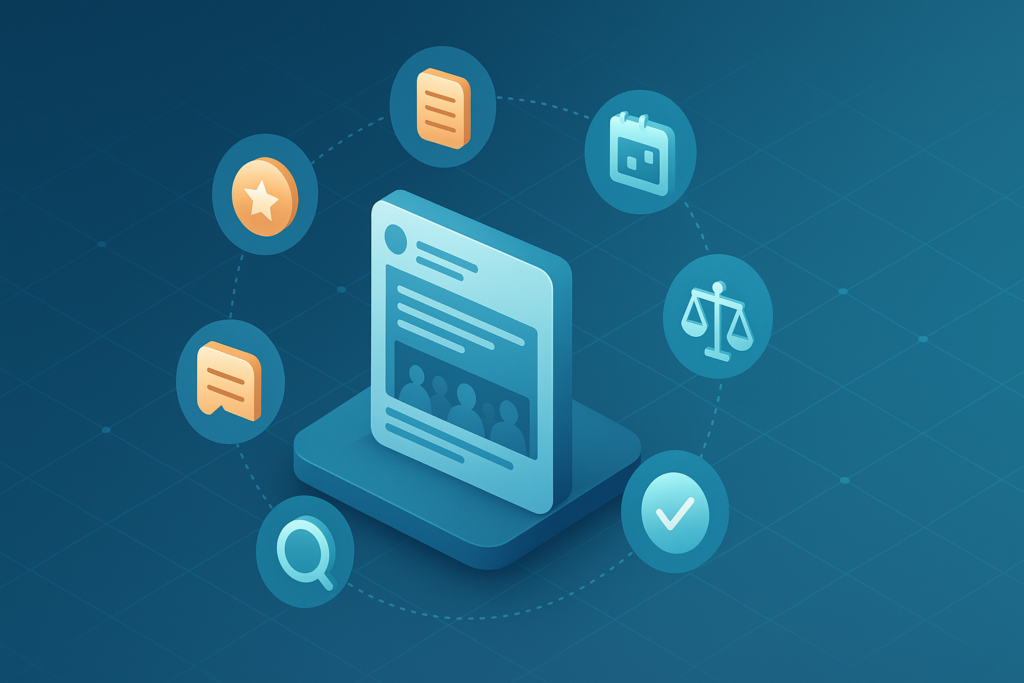Physical Address
304 North Cardinal St.
Dorchester Center, MA 02124
Physical Address
304 North Cardinal St.
Dorchester Center, MA 02124

Have you ever come across a video of a world leader saying something shocking—only to wonder if it was real? At Memory Express, we recognize that this confusion is becoming increasingly common. In 2025, AI-generated text, images, audio, and even hyper-realistic deepfake videos have advanced to the point where it’s nearly impossible to spot the difference with just the naked eye or ear. A fake article or video can spread across fast hosts and social platforms in seconds, shaping opinions before the truth is revealed.
This is the reality of today’s misinformation landscape. The problem isn’t just that these fakes exist—it’s how quickly they spread and how convincing they look. But the solution lies in turning the same technology back on itself.
By utilizing tools like AI content checkers, applying engineering principles to digital security, and adhering to smart access storage practices, we can establish robust defenses. At Memory Express, we’re preparing you with the knowledge and tools to fight back. This guide will give you a clear, actionable strategy to protect yourself in 2025—because the smartest way to fight misinformation is to let AI be your ultimate defense.

Artificial intelligence is powerful, but every tool can be used for good—or for harm. In 2025, one of the biggest dangers we face is AI-generated misinformation. Imagine scrolling online and seeing news, photos, or even videos that look real but are completely fake. AI can now create voices, images, and stories so convincing that it’s hard to spot the difference. This makes it easier for false information to spread—shaping opinions, confusing facts, and even influencing big events like elections or health choices. So, how can we protect ourselves from being tricked by content that looks true but isn’t? Recognizing the risks is the first step to staying safe in a world where not everything online can be trusted.
One of the most common forms of AI-driven misinformation comes in the form of synthetic text. Imagine browsing a news website and reading an article about a major political event. On the surface, it may look legitimate—well-written, polished, and professional. Yet, in reality, the piece could be entirely generated by artificial intelligence, crafted without any factual basis.
These AI systems are capable of producing convincing fake news, fake product reviews, or even long social media threads that push misleading narratives. What makes this particularly dangerous is how natural the writing appears. Unlike human-generated misinformation, which often contains grammatical errors or inconsistencies, AI-generated text flows smoothly and feels authentic. This makes it difficult for the average reader to distinguish between truth and fabrication. As a result, tools such as AI content detectors or free AI content checkers are becoming vital in spotting synthetic writing and protecting readers from manipulation.
While fake text is dangerous, deepfakes elevate misinformation to another level. These involve AI-generated videos or audio recordings where individuals appear to say or do things they never actually did. For example, a fabricated video of a world leader making an inflammatory statement could spread rapidly online, sparking confusion or even political unrest. The danger lies in how quickly such content can circulate—going viral in minutes, long before fact-checkers or officials have a chance to intervene. Deepfakes exploit our natural tendency to believe what we see and hear, making them one of the most powerful tools for spreading disinformation.
Historically, photographs have been considered trustworthy evidence. However, AI is eroding that trust by producing highly realistic images that can pass as genuine. With a few prompts, an AI system can create a picture of a protest that never happened, a celebrity in a fabricated scenario, or even an invented “sighting” designed to shock audiences.
These images can travel quickly across the internet, fooling millions before the truth emerges. Learning how to detect AI images—or spot AI-generated art—has now become as essential as recognizing phishing emails. Journalists, educators, and everyday users alike must approach visual content critically, while also understanding the strengths and limitations of AI detection tools.
The most alarming aspect of AI misuse is its ability to scale. Through the use of bots and automated systems, bad actors can flood online spaces with disinformation at a speed and volume humans cannot match. This means it is not just one fake article, image, or video circulating—it can be thousands, strategically repeated and amplified to create the illusion of truth. These automated campaigns shape narratives, influence opinions, and undermine trust in legitimate sources. For this reason, AI content checkers, strong verification methods, and broader digital defenses are essential to protecting individuals and societies from the overwhelming spread of falsehoods.
AI-driven misinformation—whether through synthetic text, deepfakes, fabricated images, or automated disinformation campaigns—poses a serious threat to truth and trust online. Building awareness, strengthening digital defenses, and using AI detection tools are crucial steps to help individuals and societies navigate an increasingly deceptive digital landscape responsibly.
AI has changed the way we create and consume content, but it has also opened the door to AI misuse—from fake reviews to realistic deepfakes. That’s why AI detection tools are so important in 2025. At Memory Express, we believe in using the principles of engineering, access storage, and even the power of fast hosts to build smarter systems that can protect people from AI misinformation. Let’s break down how these tools actually work in plain language.
When experts talk about AI content detectors, one of the first steps is pattern recognition. Every piece of writing or media carries little “fingerprints.” Human writing has natural rhythm, errors, and variety, while AI writing often feels too smooth or predictable. Detection tools learn to check AI-generated content by spotting these subtle differences. For example, if you’re asking, “What do AI detectors look for?”, the answer is hidden in these small but important patterns.
Tools like an AI content checker (including AI content checker free versions) scan text for these signals. They can even provide something like an AI credit score, showing the probability that a piece of content is machine-made. This helps teachers, researchers, and businesses check for AI writing and limit the misuse of artificial intelligence.
Another key method is text analysis. This involves checking for features like perplexity (how predictable the text is) and burstiness (how much variety appears in sentence structure). AI systems often produce text that looks “perfect,” but real humans add quirks, emotions, and inconsistencies. That’s why questions like “How often is AI wrong?” or “How to detect AI writing?” matter so much.
Whether you want to detect AI-generated texts, spot AI-generated content, or even understand how to avoid AI detection, text analysis provides the foundation. For educators asking, “How can teachers detect AI?”, these tools make it easier to detect AI-generated text in essays, how to check for AI on Google Docs, or even in online discussions.
AI doesn’t just write—it creates images, videos, and sound. Media forensics is the science of catching AI fake news through visual and audio clues. For example, how to detect AI images or how to spot AI art involves looking for strange details like extra fingers, blurred edges, or unnatural lighting. Similarly, how to detect AI image and video forensics uses algorithms to find digital artifacts invisible to the naked eye.
This is especially important because AI-generated misinformation can spread quickly, confusing people. Understanding what AI detection means in this context is simple: it’s about protecting truth by spotting fake visuals.
Finally, AI detection also happens at the network level. Automated bots spread false stories faster than humans can read them. Network analysis helps uncover these bot-driven campaigns by mapping out unusual posting patterns. This shows how AI detection works not just for single posts, but for entire waves of coordinated disinformation.
If you’ve ever wondered, “How do AI detectors work?” or “How does an AI detection work?”—this is the answer. They don’t just read words or watch videos; they trace how stories spread. This helps stop automated disinformation campaigns before they go viral.
Finally, AI detection tools aren’t perfect—people often ask, “Is AI detection accurate?” or “How often is AI wrong?”—but they keep improving. From text analysis to media forensics and network checks, they blend artificial intelligence foundations with human oversight.
While detection protects us, AI also brings positives—whether for using AI for research, writing journal entries, or creating with tools like best AI writing tools, SEO writing AI, LinkedIn headline generator, AI slogan generator, or YouTube description generator.
At Memory Express, we believe the goal isn’t to avoid AI but to use it wisely. With access storage, the principles of engineering, and smart detection systems, we can guard against AI misinformation while still enjoying AI’s benefits.
Misinformation moves quickly online, and in 2025, it has become harder than ever to tell truth from fiction. At Memory Express, we believe the best way to stay safe is to combine smart habits with powerful tools. Below is a step-by-step guide to help you protect yourself from misleading articles, fake images, and manipulated videos. By applying the principles of engineering, learning how to question sources, and using tools like an AI content checker, you’ll be ready to face the misinformation storm spreading across today’s fast hosts.

The first step in detecting misinformation is mindset. Whenever you see a shocking headline or viral video, pause. Ask yourself: Who created this? Why now? What’s their motive? At Memory Express, we encourage readers to think critically, because most misinformation relies on our impulse to react, not reflect.
This is where the principles of engineering come in. Engineers test, measure, and verify before accepting results. You can do the same: look for evidence, ask if the story aligns with facts, and save what you find. If content is likely to be deleted from fast hosts, use access storage methods to screenshot or archive it. That way, you’ll always have a copy when you double-check later.
Not all misinformation comes in videos or pictures. Many fake reviews, articles, and posts are created with AI. To check AI-generated content, tools like GPTZero and Originality.ai can help. An AI content checker looks for patterns in text that humans don’t naturally create. If you’re unsure about an article, running it through a checker can give you peace of mind.
At Memory Express, we often remind readers that while detectors aren’t perfect, they provide useful insights. Think of them as your assistant: they can highlight suspicious passages, but it’s up to you to interpret them. By combining tool results with your own reasoning and the principles of engineering, you’ll build stronger defenses. Always use access storage to save results from your scans, especially if you’re comparing multiple tools across different fast hosts.
Visual misinformation is even trickier. Fake photos and deepfakes spread quickly, and they look incredibly real. A simple trick is to run images through reverse image search. This helps you see if the same picture was used in a different context. Tools can also highlight whether an image may have been AI generated.
Here’s where an AI content checker for media plays a role. While some are built for text, others can flag suspicious patterns in photos or videos. At Memory Express, we recommend pairing these tools with careful observation: strange details like distorted hands or uneven backgrounds often reveal synthetic visuals. When misinformation spreads on fast hosts, use access storage to archive the original version. Later, you can compare it to updates or fact-check reports, ensuring you know exactly how the content evolved.
No matter how convincing a piece of content looks, verification is key. Reliable outlets and fact-checking platforms are your best friends. This is what “verification” really means: checking a claim against trusted data. At Memory Express, we suggest creating a habit of cross-referencing.
Apply the principles of engineering here: test the claim against multiple independent sources. If one post says something extraordinary but no major outlet covers it, that’s a red flag. If a news story spreads rapidly on fast hosts, use access storage to capture it and then see what fact-checkers publish later. You can also run suspicious text through an AI content checker to get another layer of confirmation.
The last step is action. Once you confirm content is false, report it. Most platforms make this easy: flag the post, share links to fact-checks, and add a short note if appropriate. At Memory Express, we encourage readers to take reporting seriously. Every flagged post helps slow the spread of lies.
Here again, think like an engineer. The principles of engineering remind us to document our work. Keep screenshots, links, and your reasoning stored safely. If the platform asks for evidence, you’ll be ready. When dealing with fast-moving content on fast hosts, always use access storage so you don’t lose track of what you’ve flagged.
Fighting misinformation requires vigilance, tools, and community effort. At Memory Express, we believe that anyone can learn to spot fakes with the right mindset and technology. By applying the principles of engineering, saving key content with access storage, using fast hosts wisely, and running suspicious material through an AI content checker, you can protect yourself and others from falling into the trap of AI misinformation.
The future of misinformation isn’t slowing down—it’s evolving. As generative models become more advanced, the threat of AI misuse will grow, producing content that looks and feels real. Imagine a flood of AI fake news, deepfake videos, and manipulated images that blur the line between fact and fiction. For everyday users, it will be harder than ever to check AI-generated content with just the human eye.
At Memory Express, we see this as a call to action. The next wave of defenses will rely on stronger AI content detectors and smarter AI content checker tools, some even available as AI content check free versions. These systems will blend the principles of engineering with the speed of fast hosts to flag misinformation before it spreads too far. The future may even include ratings similar to an AI credit score, helping users understand how trustworthy a piece of text or media really is.
But technology alone isn’t enough. The real solution lies in building digital literacy—teaching people what AI detection is, how AI detection works, and why it matters. With stronger defenses, better access to storage of verified content, and informed communities, we can face the AI arms race with confidence.
For deeper insight, check out this blog on tackling AI misinformation: “AI and Misinformation: How to Combat False Content in 2025” from Columbia Business School’s Insights magazine

The rise of AI misuse means we all need smarter habits to protect ourselves. From spotting AI fake news to learning how to detect AI writing or how to detect AI images, the key is awareness. We’ve seen how AI content detectors and tools like an AI content checker can help check AI-generated content, sometimes even through AI content check options. These systems may provide an AI credit score of likelihood, but always remember: what does verification mean? It means using evidence, not assumptions, to test content.
At Memory Express, we believe in combining technology with habits. Apply the principles of engineering to fact-checking: test, measure, and confirm before sharing. Save proof with access storage tools so misinformation from fast hosts doesn’t slip away. And always ask critical questions—because AI misconceptions thrive when we don’t pause to reflect.
The path forward is empowerment. By knowing what AI detection is, how AI detection works, and is AI detection is accurate, we can strengthen digital defenses. Share this guide, encourage others to explore detection tools, and stay updated with Memory Express. Together, we can face AI misinformation with confidence and clarity.
1. What is AI detection?
AI detection is the process of identifying whether text, images, audio, or video has been created or manipulated by artificial intelligence. Tools like AI content detectors and an AI content checker analyze writing style, media artifacts, or network behavior to help check AI-generated content.
2. How does AI detection work?
Detection tools look for hidden “fingerprints.” In text, this may be low burstiness or unnatural predictability. For media, they search for artifacts like distorted hands in AI fake news images or lip-sync issues in deepfakes. Understanding how does AI detection work helps you trust results but also apply human judgment.
3. Is AI detection accurate?
Accuracy varies. Many tools provide probabilities (like an AI credit score) rather than absolute answers. That’s why it’s smart to combine multiple detectors and critical thinking.
4. How can teachers detect AI writing?
Teachers can use AI content checker free or AI content detector free tools to flag suspicious essays. They may also look for sudden changes in tone, missing sources, or perfectly polished grammar.
5. What do verification mean in practice?
Verification means confirming claims with reliable evidence. This could be using fact-checking sites, reverse image search, or applying the principles of engineering to test a source before sharing.
6. How do I protect myself from AI misinformation?
Stay skeptical, use access storage to archive content before it disappears from fast hosts, and always cross-check sources. Awareness and practice are your best defenses.
For more tips, tools, and strategies, visit IceBergAIContent and stay updated with the latest guides on AI defense and digital literacy.